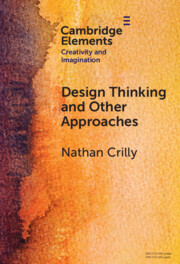68 results
Using design thinking and community development principles to optimise the interaction between informal and formal social protection systems
-
- Journal:
- Journal of International and Comparative Social Policy , FirstView
- Published online by Cambridge University Press:
- 07 March 2025, pp. 1-21
-
- Article
-
- You have access
- Open access
- HTML
- Export citation
Framework for a problem-solving educational program integrating medicine and design disciplines at a Japanese university
-
- Journal:
- Design Science / Volume 11 / 2025
- Published online by Cambridge University Press:
- 17 January 2025, e3
-
- Article
-
- You have access
- Open access
- HTML
- Export citation
10 - Leading Change in Global Organizations
- from Part III - Executing Strategy in a Global Context
-
- Book:
- International Management Behavior
- Published online:
- 15 March 2025
- Print publication:
- 16 January 2025, pp 344-370
-
- Chapter
- Export citation
20 - The Open Law Lab Blog
- from III - How Legal Design Works
-
-
- Book:
- Legal Design
- Published online:
- 19 December 2024
- Print publication:
- 19 December 2024, pp 319-326
-
- Chapter
- Export citation
18 - James v Birnmann
- from III - How Legal Design Works
-
-
- Book:
- Legal Design
- Published online:
- 19 December 2024
- Print publication:
- 19 December 2024, pp 278-305
-
- Chapter
- Export citation
11 - Creativity and Design
- from Part III - The Factors Influencing Group Success
-
- Book:
- Groups
- Published online:
- 12 December 2024
- Print publication:
- 05 December 2024, pp 235-259
-
- Chapter
- Export citation
Measuring the effectiveness of programmed instructions (PI) to learn design thinking concepts for secondary school students
-
- Journal:
- Design Science / Volume 10 / 2024
- Published online by Cambridge University Press:
- 03 December 2024, e40
-
- Article
-
- You have access
- Open access
- HTML
- Export citation
Design thinking: catalysing change in the educational ecosystem – a framework for future challenges
-
- Journal:
- Design Science / Volume 10 / 2024
- Published online by Cambridge University Press:
- 22 November 2024, e34
-
- Article
-
- You have access
- Open access
- HTML
- Export citation

Design Thinking and Other Approaches
- How Different Disciplines See, Think and Act
-
- Published online:
- 10 June 2024
- Print publication:
- 03 October 2024
-
- Element
- Export citation

Design Creativity
-
- Published online:
- 04 June 2024
- Print publication:
- 27 June 2024
-
- Element
-
- You have access
- Open access
- HTML
- Export citation
Leveraging design thinking in MBSE: mitigating data and information uncertainties – an integration model approach
-
- Journal:
- Proceedings of the Design Society / Volume 4 / May 2024
- Published online by Cambridge University Press:
- 16 May 2024, pp. 2533-2544
-
- Article
-
- You have access
- Open access
- Export citation
Crisis: a driver for tourism innovation and service design?
-
- Journal:
- Proceedings of the Design Society / Volume 4 / May 2024
- Published online by Cambridge University Press:
- 16 May 2024, pp. 2343-2352
-
- Article
-
- You have access
- Open access
- Export citation
Human in the loop: revolutionizing industry 5.0 with design thinking and systems thinking
-
- Journal:
- Proceedings of the Design Society / Volume 4 / May 2024
- Published online by Cambridge University Press:
- 16 May 2024, pp. 245-254
-
- Article
-
- You have access
- Open access
- Export citation
Innovation of meaning: design-driven study based on the interpretive theory of new meaning
-
- Journal:
- Proceedings of the Design Society / Volume 4 / May 2024
- Published online by Cambridge University Press:
- 16 May 2024, pp. 35-44
-
- Article
-
- You have access
- Open access
- Export citation
Nurture employees’ creative behaviors: unveiling the impact of design thinking on human organizational behavior
-
- Journal:
- Proceedings of the Design Society / Volume 4 / May 2024
- Published online by Cambridge University Press:
- 16 May 2024, pp. 295-304
-
- Article
-
- You have access
- Open access
- Export citation
Understanding the art of design thinking facilitation: a novel instrument for observing instructional strategies used by facilitators
-
- Journal:
- Proceedings of the Design Society / Volume 4 / May 2024
- Published online by Cambridge University Press:
- 16 May 2024, pp. 2845-2854
-
- Article
-
- You have access
- Open access
- Export citation
Design team formation using self-assessment and observer-assessment techniques: mapping practices in a global network of universities
-
- Journal:
- Design Science / Volume 10 / 2024
- Published online by Cambridge University Press:
- 21 February 2024, e7
-
- Article
-
- You have access
- Open access
- HTML
- Export citation
Design and assistive technology: a tinder match waiting to happen
-
- Journal:
- Design Science / Volume 10 / 2024
- Published online by Cambridge University Press:
- 12 February 2024, e5
-
- Article
-
- You have access
- Open access
- HTML
- Export citation
Part V - Gaining Ecosystem Momentum
-
- Book:
- Digital Innovation Strategy
- Published online:
- 21 December 2023
- Print publication:
- 21 December 2023, pp 199-268
-
- Chapter
- Export citation
1 - Design Thinking in Organization Design
-
-
- Book:
- Designing Adaptive Organizations
- Published online:
- 09 November 2023
- Print publication:
- 23 November 2023, pp 1-22
-
- Chapter
- Export citation

